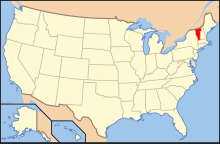
Paleontology in Vermont comprises paleontological research occurring within or conducted by people from the U.S. state of Vermont. Fossils are generally uncommon in Vermont. Nevertheless, however, significant finds have been made in the state.[1] Very few fossils are known in Vermont east of the Green Mountains due to the type of rock underlying that area.[1] During the early part of the Paleozoic era, Vermont was covered by a warm, shallow sea that would end up being home to creatures like brachiopods, corals, crinoids, ostracoderms, and trilobites. There are no rocks in the state from the Carboniferous, Permian, Triassic, or Jurassic periods. The few Cretaceous rocks present contain no fossils. The Paleogene and Neogene periods are also absent from the local rock record. During the Ice Age, glaciers scoured the state. At times the state was inundated by seawater, allowing marine mammals to venture in. After the seawater drained away the state was home to mastodons. Local fossils had already attracted scientific attention by the mid-19th century when mastodon remains were found in Rutland County. In 1950 a major Paleozoic invertebrate find occurred. The Pleistocene Beluga whale Delphinapterus leucas is the Vermont state fossil.